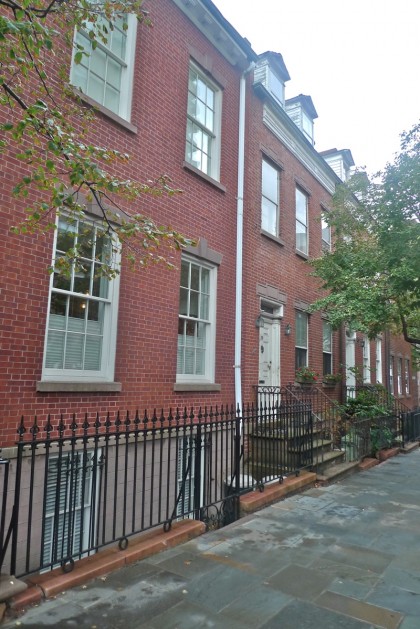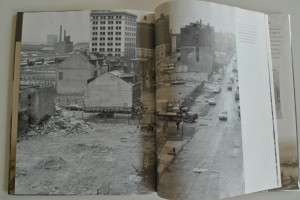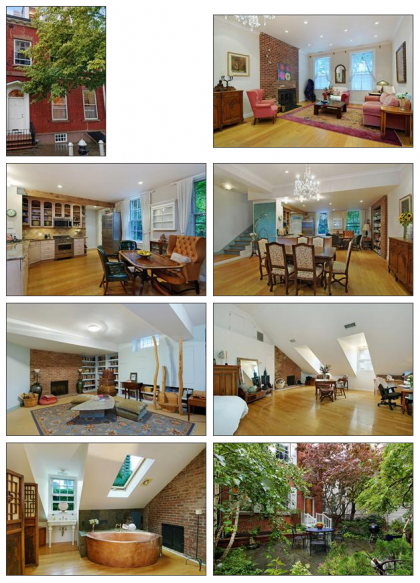Nosy Neighbor: What’s the Story Behind Those Harrison Townhouses?
 What’s the story behind that cute row of houses on Harrison Street, west of Greenwich? I always wonder as I walk to work. —A.
What’s the story behind that cute row of houses on Harrison Street, west of Greenwich? I always wonder as I walk to work. —A.
Here’s what the AIA Guide to New York City (4th edition) says: “These were originally elegant Federal houses, recycled (and rejected) as produce market buildings, 2 on Harrison Street and a group from a now extinct part of Washington Street. Their reincarnation included moving the Washington Street group 2 blocks to this enclave. [The guide says the “Harrison Street Houses” (25-41 Harrison) were finished being relocated and restored in 1975 by Oppenheimer, Brady & Vogelstein.] They have been lovingly restored—perhaps too lovingly: the patina from the passage of time has been totally erased (cf. Williamsburg, Va.). Note that [John] McComb, City Hall’s co-architect, lived in one!” (That’s 27 Harrison—more on it in a minute.)
The guide lists the dates and architects of the individual houses, although it’s not clear which info goes with which house; suffice it to say, I hope, that most were originally built in 1827 and 1828, although the earliest is from 1796.

This is worth clicking to enlarge: It’s a photo by Michael Harvey (from Oliver E. Allen’s “Tales of Old Tribeca” of a house being moved from Washington Street to Harrison Street.
In his book, Tales of Old Tribeca, Oliver E. Allen devoted a chapter to the moving of the houses. (The book is a treat; used copies are available on Amazon.) “The idea of saving the Federal houses originated in the 1960s when a city agency responsible for clearing the urban renewal area asked the recently formed Landmarks Preservation Commission whether any buildings in the area were worthy of being spared the wrecker’s ball. It was known that the district had once been largely covered by two-and-a-half-story wood or brick residences, but most of these had been torn down and replaced in the 19th century by larger commercial structures; had any survived in good condition? Landmarks replied that there were no fewer than nine worth saving, all of which should probably be given landmark designation.” Also, Allen notes that the facade of what is now 27A Harrison collapsed during the move and had to be replaced. (The photo above, from Tales of Old Tribeca, was taken by artist and writer Michael Harvey from his apartment at 323 Greenwich.)
 The house that architect John McComb—he of City Hall—lived in, 27 Harrison, is currently for sale for $5.4 million. “The four story building is approximately 4,000 square feet and 25 feet wide with four bedrooms, four and a half baths, four fireplaces and a charming garden,” says the Corcoran listing. “The parlor floor is mostly open providing a ‘loft-like’ space which is bathed in light, a large living area with high ceilings, fireplace, oversized windows, dining area, powder room, and a chef’s kitchen with extensive granite counter tops and stainless steel appliances. The kitchen overlooks the serene 575 square foot garden which is planted with Birch trees and Wisteria. The English basement is nicely finished with a family room and fireplace, a bedroom, bath, and a large laundry room. The third floor has two bedrooms, two baths, excellent storage space and a hall landing with a built-in window seat overlooking the garden. The spectacular master suite occupies the entire fourth floor offering high-pitched ceilings, glorious light from the skylight and dormer windows, two fireplaces, and an open bath with a lovely copper soaking tub and a custom granite double shower. Located on a tree-lined, cobblestone block in the heart of Tribeca, the McComb House was built in 1796 by the architect of City Hall, John McComb, Jr. Moved from its original site, the house was designated as a landmark in 1969.” The photos are small; click to enlarge.
The house that architect John McComb—he of City Hall—lived in, 27 Harrison, is currently for sale for $5.4 million. “The four story building is approximately 4,000 square feet and 25 feet wide with four bedrooms, four and a half baths, four fireplaces and a charming garden,” says the Corcoran listing. “The parlor floor is mostly open providing a ‘loft-like’ space which is bathed in light, a large living area with high ceilings, fireplace, oversized windows, dining area, powder room, and a chef’s kitchen with extensive granite counter tops and stainless steel appliances. The kitchen overlooks the serene 575 square foot garden which is planted with Birch trees and Wisteria. The English basement is nicely finished with a family room and fireplace, a bedroom, bath, and a large laundry room. The third floor has two bedrooms, two baths, excellent storage space and a hall landing with a built-in window seat overlooking the garden. The spectacular master suite occupies the entire fourth floor offering high-pitched ceilings, glorious light from the skylight and dormer windows, two fireplaces, and an open bath with a lovely copper soaking tub and a custom granite double shower. Located on a tree-lined, cobblestone block in the heart of Tribeca, the McComb House was built in 1796 by the architect of City Hall, John McComb, Jr. Moved from its original site, the house was designated as a landmark in 1969.” The photos are small; click to enlarge.
Got a question? Email it to tribecacitizen@gmail.com.
Previous Nosy Neighbor posts:
• What are those white things at 137 Franklin?
• What’s that thing at W. Broadway and Leonard?
• What happens to old cobblestones?
• Are buses allowed to idle on Laight?
• What’s happening with the Verizon building?
• Will the construction at Hudson and Laight ever end?
• What is Esoteric on Walker Street?
• What’s up with the building under renovation on Franklin?
• Is N. Moore getting cobblestoned?
• What are those orange awnings for?
• What’s happening at 73 Warren?
• Can you recommend any Tribeca picture books?
• Why are those shuttles on Greenwich?
• What’s coming to 15 Canal Street?
• Who enforces sidewalk-café regulations?
• What’s going on at 27 Desbrosses?
• What happened to the Lilac?
• When will those trailers on West Street go away?
• Do you know anything about 20-24 Varick?
• What’s happening to my parking lot?
• Is Pier 26 being worked on again?
• What’s up with Jin Market?
• What are those black pellets on Pier 25?
• What do the characters on 47 Vestry mean?
• When is T.J. Maxx opening?
• Where is the Special Forces monument going?
• Who’s moving into 151 Hudson?
• What’s going on at 172 Duane?
• Where is Compose’s pastry chef cooking now?
• What’s up with those Verizon carts?
• Where was the original Blues Bar?
• Who are the guys in the geeky pants?
• Why are the windows above Ponte’s boarded up?
• Can we walk on the West Street medians?
• What’s going on in 157 Hudson?
• What’s the new painting at 153 Hudson?
• What’s up with 55 Warren/55 Murray?
• What is this P.C. Richard & Son Theater I keep hearing about?
• What’s the story behind the lights at 289 Church?
• What’s the Dream House at 275 Church?
• How come every every film and TV shoot seems to have a trailer with doors marked “Lucy” and “Desi”?


















Thanks for sating my curiosity on this one, TC! Super interesting!!
P.S. Don’t you think the AIA guide should be made into an app? I always wish I had it to consult when I run into interesting buildings around town, and in book form it’s not exactly a pocket guide!
@Annika: What I actually wish is that the AIA Guide would be way more thorough. It’s rare that a building I’m curious about (which is any old building, to be fair) is in the book. And then we can work on the app!